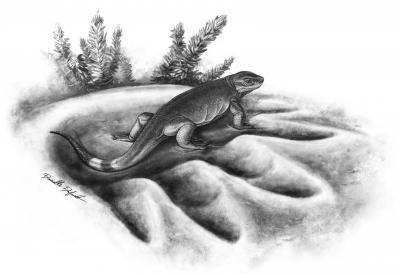A new fossil may provide evidence that large caseid herbivores, the largest known terrestrial vertebrates of their time, evolved from small non-herbivorous members of that group, according to a study published April 16, 2014 in the open-access journal PLOS ONE by Robert Reisz from University of Toronto and Jörg Fröbisch of the Museum für Naturkunde.
The origin and early evolution of vertebrates living on land led to major changes in the structure of terrestrial ecosystems. The first appearance of herbivores played a pivotal role in this transformation, and a newly discovered species, Eocasea martini, from Kansas, USA may provide information about early caseids. In this study, researchers describe and discuss the evolutionary and paleoecological implications of this new taxon.

Smallest and largest caseid: This is a reconstruction of 300 million year old tiny carnivorous Eocasea in the footprint of 270 million year old largest known herbivore of its time, Cotylorhynchus.
(Photo Credit: Danielle Dufault)
The oldest caseid recorded, E. martini was from the Late Carboniferous, about 305-300 million years ago. The characteristics of the fossil indicate that it was likely a small carnivore. Caseids are characteristically herbivores, so this fossil may provide evidence that large caseid herbivores evolved from small carnivorous members of that group. This pattern is mirrored by three other groups, documenting multiple, independent, but temporally staggered, origins of herbivory and a possible increase in body size among early terrestrial tetrapods, leading to patterns consistent with modern terrestrial ecosystems.
"The evolution of herbivory was revolutionary to life on land because it meant terrestrial vertebrates could directly access the vast resources provided by terrestrial plants," says paleontologist Robert Reisz, Department of Biology. "These herbivores in turn became a major food resource for large land predators."
Source: PLOS